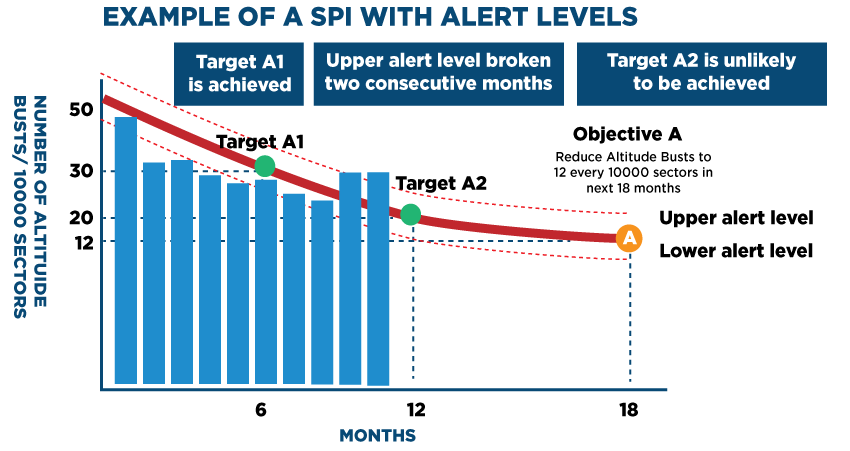Although ICAO Annex 19 does not mandate the use of safety alerting (sometimes called triggers), they can be used to good effect if implemented properly. By using safety alerts, management can allow their aviation safety management system to monitor performance for all SPIs and only receive notifications if levels of events exceed pre-set parameters; above and below the target line.
Safety alerting can be used when establishing SPIs and SPTs. However, such alerts should be used with caution. Alert levels are best suited to technical issues or frequent events that have sufficient and reliable data to form a meaningful trigger process. Without sufficient or reliable data, it is likely that management will receive a number of false triggers which can, over time, result in a high degree of complacency towards the alerting system.
If used correctly, the set-up of an alerting system can be beneficial in that it allows the organisation’s software system to monitor progress towards safety goals, thus, freeing up management to concentrate on more pressing safety issues.
Alerting was first used by the engineering fraternity as a way of monitoring component reliability. It now has its place in the safety monitoring function. The most usual way to set safety alerts is to determine a baseline performance. For example, the average monthly rate, per 1000 flights, for unstable approaches over the last 12 months. Using this average over 12 months’ worth of data it is possible to determine the standard deviation above and below the average. Indeed, it is common to use 1, 2 and 3 Standard Deviations as alert levels 1, 2 and 3. This is demonstrated in figure 1 below:
Ultra-Safe Airlines – Unstable Approaches

In the diagram above, it can be seen that Ultra-Safe airlines have decided to monitor their performance regarding unstable approaches. They have used the previous 12 months’ worth of safety data to determine their 3 alert levels by using the 1,2 and 3 standard deviations from the 12-month average. The objective was to maintain the same performance for the following year; therefore, this was also the SPT. Unfortunately, things have not gone well in this case and clear management action is required.
An alternative approach could be the establishment of a changing alert level to reflect the anticipated rate at which improvements will be achieved. In our example from the previous Blog (LINK <<A Practical Example of a Safety Objective and its Associated SPI and SPTs>>), the targets were set on the assumption that the main improvements would be achieved in the first 6 months; thereafter a slower rate of progress would be observed. To reflect this, the alert levels have been selected as 10% above and below the desired rate of improvement. Therefore, the alert level varies throughout the timeline of the SPI. In the case below at figure 2, the company has been monitoring the SPI (Altitude Busts per 10000 flights) and reporting progress each month at the Safety Action Group (SAG) meeting. For the first 6 months, progress was good, and the first target was met. Unfortunately, thereafter, performance of this SPI deteriorated and by month 10, the upper alert level was breached in two consecutive months. This would activate an automatic trigger to the safety management team alerting them to this fact. Clearly, some management action is required in order to improve performance in this safety area.

Identifying Management Actions
Arguably the most important outcome of establishing a safety performance management structure is the presentation of information to the organisation’s decision makers so they can make decisions based on current, reliable safety data and safety information. The aim should always be to make decisions in accordance with the safety policy and towards the safety objectives.
In relation to safety performance management, data-driven decision-making, is about making effective, well-informed decisions based on the results of monitored and measured SPIs, or other reports and analysis of safety data and safety information. Using valid and relevant safety data combined with information that provides context supports the organisation in making decisions that align with its safety objectives and targets. Contextual information may also include other stakeholder priorities, known deficiencies in the data, and other complementary data to evaluate the pros, cons, opportunities, limitations and risks associated with the decision. Having the information readily available and easy to interpret, helps to mitigate bias, influence and human error in the decision-making process.
This process or managing an effective safety management system can only work if there is an enterprise-wide approach to reporting and data collection. A well-designed and supported SMS software solution will help safety managers obtain information and data that can support their respective safety management priorities, and thereby provide the wider organisation with the information through which SPIs, SPTs and Safety Triggers can be established. It will result in a safer airline organisation.
Learn how the right safety management software can help support your airline’s safety investigation, risk and audit management and compliance solutions. Download our free guide to find out how to select one that benefits your airline.
Note: Information in this article is taken from ICAO Document 9859.
Image from twentyphotos Envato Elements


